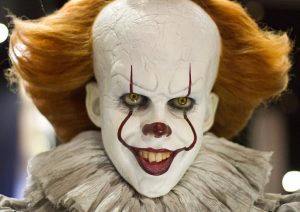From “It” (1990 and 2017/2019), based on Stephen King’s novel, portrayed by Tim Curry and later by Bill Skarsgård.
Introduction
Pennywise the Dancing Clown is one of the most iconic and chilling characters in horror literature and cinema. Created by Stephen King, Pennywise first appeared in the 1986 novel “It” and has since become a symbol of terror, haunting the nightmares of readers and viewers alike. This character masterfully blends the innocuous with the insidious, turning the figure of a clown – typically associated with joy and laughter – into a conduit of unadulterated fear.
Origins and Concept
Stephen King’s inspiration for Pennywise emerged from a desire to create a character that could embody the fears of children. He wanted a figure that was familiar yet terrifying, and thus, the concept of a clown that preys on the fears of the young residents of Derry, Maine, was born. Pennywise is not just a clown, however; it is a manifestation of an ancient cosmic evil that awakens every 27 years to feed on the town’s children.
Character Description
Pennywise, as depicted in King’s novel and its adaptations, is a shapeshifting entity. While its preferred form is that of a clown with silver suit and orange pompoms, it can transform into whatever its victim fears the most. This ability makes Pennywise a deeply personal fear for each character it encounters. The clown’s most distinguishing features are its sinister smile, the haunting, glowing eyes, and the eerie voice that ranges from playfully mocking to deeply menacing.
Adaptations in Film and Television
Pennywise gained widespread notoriety through its portrayals in film and television. In the 1990 TV miniseries, Tim Curry delivered a performance that is both charismatic and terrifying, bringing a sense of malicious glee to the character. The 2017 and 2019 film adaptations saw Bill Skarsgård take on the role, offering a more overtly menacing and otherworldly interpretation. Skarsgård’s portrayal emphasized the creature’s inhumanity and predatory nature, adding a new layer of horror to the character.
Pennywise’s Role and Symbolism
Pennywise is more than just a monster; it is a symbol of the fears and traumas that haunt individuals. In “It,” the children, known collectively as the Losers’ Club, each confront their personal nightmares, which Pennywise exploits. The character thus becomes a metaphor for the challenges of growing up and facing one’s deepest fears. The creature’s defeat by the Losers’ Club signifies not just the triumph over a monster, but also the overcoming of childhood traumas and the transition into adulthood.
Cultural Impact
The cultural impact of Pennywise cannot be overstated. The character has influenced the horror genre significantly, creating a template for villains that blend the familiar with the horrifying. Pennywise has become a part of the collective consciousness, often referenced in various forms of media and Halloween costumes. The clown has also contributed to the ‘creepy clown’ phenomenon, intensifying the clown phobia (coulrophobia) in popular culture.
Conclusion
Pennywise the Dancing Clown stands as a testament to Stephen King’s ability to tap into the deepest fears of the human psyche. This character is not only a staple of horror fiction but also a representation of the universal fears that we all carry within us. Pennywise terrifies not just because it is a monster lurking in the sewers, but because it reflects the personal demons we all must face. Through its various adaptations and enduring presence in popular culture, Pennywise continues to dance in the dark corners of our imagination, a chilling reminder of the power of fear itself.


